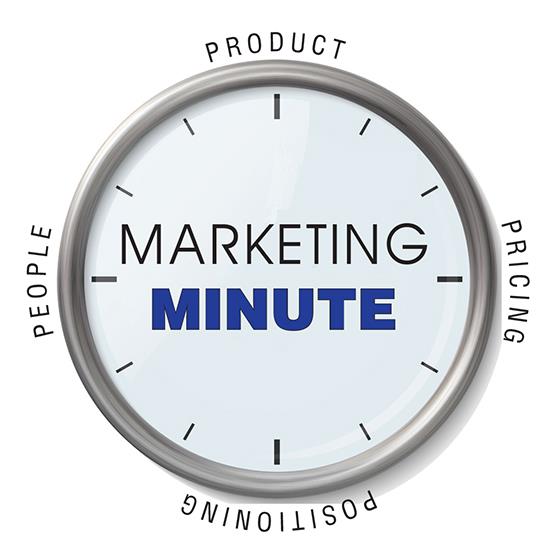Marketing Minute: Building a brand when others run scared - June 2020
By Paul Friederichsen
As of this writing, the country is slowly starting to reopen. States and municipalities are each following their own timetables and guidelines, controlling social distancing, mask-wearing and the like. The outlook is still uncertain regarding the speed with which business returns to “normalcy” (whatever that is).
What is certain, however, is the impact on the psyche and behavior of the consumer. The economic shutdown caused by the pandemic over the last two months has thoroughly baked in a big dose of anxiety, concern and paranoia, not to mention spurred horrendous job losses. Malls, stores and restaurants are reopening, but traffic has been tepid and sluggish. Unless your brand is Clorox, Amazon, Netflix or Regeneron Pharmaceuticals, this pandemic marketplace has been especially toxic.
B2C brands need to stay close to their customers to stay relevant and engaged, even in times like these. That’s because brand/customer relationships are built on a consistent transactional basis, and social distancing has a nasty way of interrupting that at the retail level.
Likewise, for B2B brands, traditional forms of brand/customer interaction have been stymied. For example, manufacturer sales representatives have been unable to travel for in-person meetings and training sessions. For years, manufacturers have relied of their sales and technical support to be their brand ambassadors, building coveted relationships with customers. That practice took a blow when COVID-19 hit.
Without a doubt, the virus has become everyone’s ultimate “marketing” adversary. It thrives in the daily exposure of untold billions in media coverage. For some brands with “pre-existing conditions,” it has already succeeded in beating them down. Neiman Marcus was weak going into the pandemic and has now filed for bankruptcy. The Sweet Tomatoes restaurant chain’s popular salad bar business model was its undoing because of the limitations on delivery and carry-out. And thousands of small businesses will never return, in spite of government assistance.
Businesses that can survive the day-to-day during the crisis must work to remain connected to their customers to preserve the relevance of their brands. Because the reopening of the economy is on an uncertain timetable, there are initiatives that marketers must pursue to ensure marketplace viability on the other side. Recent examples in the floorcovering industry include:
Thought leadership and service. For example, the World Floor Covering Association stepped up to the plate by developing a clearinghouse of information for the industry on coping with the pandemic.
Transparency and responsiveness. Several brands quickly and clearly stated their COVID-19 policies for employees and customers. They led by example and earned admiration and media coverage for their actions.
Technological workarounds. By adopting online communication tools like Zoom to conduct training and stay connected with sales teams and customers, many brands are discovering a superior and more cost-efficient way to stay connected and control their message.
Joining the fight. Many brands began producing PPE materials to help frontline medical teams wage war on the coronavirus. These brands highlighted their efforts through social media and public relations that inspired all of us.
Extended terms. Some businesses helped dealers choose product now and pay later-now offered by larger manufacturers.
Spreading the word and being positive. Many brands are making a concerted effort to “like” and share social media content that supports and encourages not only others in the floorcovering industry but also their fellow Americans, healthcare professionals and first responders.
Wearing protective gear and limiting close contact. Floorcovering dealers, contractors and installers everywhere have adopted and expanded best practices for more pandemic-sensitive customer service.
All of these examples have one thing in common: empathy. Brands must empathize with their customers, who will, in turn, inform their actions in the marketplace. This keeps them relevant and builds long-term trust. But actions like these are only part of the story. Whether you are a mill, a distributor, a contractor, a retailer or a trade group, you must take advantage of this time to do the following:
Evaluate your communication infrastructure-your website, SEO, internal channels, social platforms, etc.-and make changes and updates as needed.
Ramp up (yes, I said that) your brand exposure via advertising, social media, PR and the like. The tendency for many is to hunker down and go quiet. Yet studies have shown that consistent advertisers through the Great Recession came out ahead on the other side of it.
Get creative. This pandemic could be the mother of invention for you. Go for it. If you ever considered developing a new way to reach your customer or adjust your position in the marketplace, now is the time.
Keep moving. As Winston Churchill said, that’s what you do when you’re going through hell.
Many agree that the post-pandemic marketing landscape will look different. Quarantines have opened the door wider to telecommuting and with it, a greater reliance on digital communications such as video conferencing. Mandatory business closures and retail supply chain disruptions and shortages have pushed reluctant consumers to embrace online purchasing. Homebound homeowners determined to make improvements may overcome their lack of DIY confidence-Home Depot parking lots are still full. Prepare your brand now.
See you on the other side.
Copyright 2020 Floor Focus
